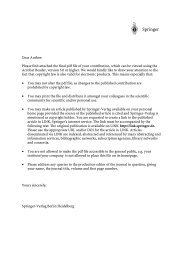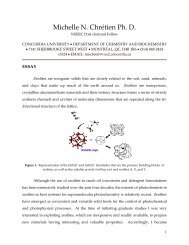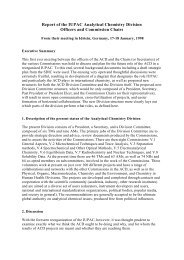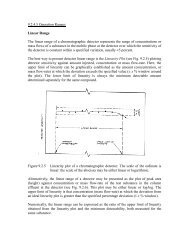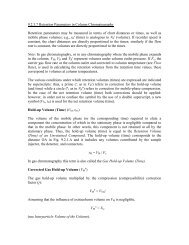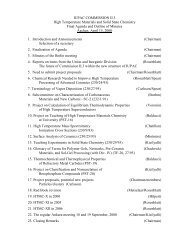Vitamin Fortification of Lipid-Based Products
Vitamin Fortification of Lipid-Based Products
Vitamin Fortification of Lipid-Based Products
Create successful ePaper yourself
Turn your PDF publications into a flip-book with our unique Google optimized e-Paper software.
VITAMIN FORTIFICATION OF<br />
LIPID-BASED LIPID BASED PRODUCTS<br />
Delia B. Rodriguez-Amaya<br />
Rodriguez Amaya<br />
Departamento de Ciência de Alimentos<br />
Faculdade de Engenharia de Alimentos<br />
Universidade Estadual de Campinas<br />
Campinas, SP, Brasil
FORTIFICATION<br />
Addition <strong>of</strong> nutrients in amounts<br />
significant enough to render the food<br />
a good to superior source <strong>of</strong> the<br />
added nutrients. This may include<br />
addition <strong>of</strong> nutrients not normally<br />
associated with the food or addition<br />
to levels above that present in the<br />
unprocessed food.
ADVANTAGES OF FOOD<br />
FORTIFICATION<br />
Probably one <strong>of</strong> the most efficient as well<br />
as one <strong>of</strong> the most cost-effective means <strong>of</strong><br />
eliminating micronutrient malnutrition.<br />
Requires no change in food habits.<br />
Does not change the characteristics <strong>of</strong> the<br />
food.
AMA-IFT AMA IFT-FNB FNB GUIDELINES<br />
GENERAL CRITERIA<br />
The intake <strong>of</strong> the particular nutrient is<br />
inadequate for a substantial portion <strong>of</strong> the<br />
population.<br />
The food (or category) is consumed by<br />
most individuals in the target population.<br />
There is reasonable assurance that excessive<br />
intake will not occur.<br />
The cost is reasonable for the intended<br />
population.
U.S. FOOD AND DRUG<br />
ADMINISTRATION GUIDELINES<br />
FORTIFICANT<br />
Stable under customary conditions <strong>of</strong><br />
storage, distribution, and use.<br />
Physiologically available from the food.<br />
Present at optimal levels, without increasing<br />
the risk <strong>of</strong> excessive intake or toxic effects.<br />
Suitable for its intended purpose and in<br />
compliance with provisions (i.e. regulations)<br />
governing safety.
FOOD VEHICLE FOR<br />
FORTIFICATION<br />
Consumed by a sizeable proportion <strong>of</strong><br />
the target population.<br />
Processed centrally to allow controlled<br />
fortification.<br />
Distributed through a widespread network<br />
so that it reaches all regions <strong>of</strong> the country.<br />
Inexpensive, so that it can be consumed<br />
by all income groups.
FOOD VEHICLE FOR<br />
FORTIFICATION<br />
Not change in taste, colour, or appearance<br />
on fortification.<br />
Not lose the nutrient on further processing<br />
or cooking.<br />
Have a stable and uniform per capita daily<br />
intake, so that the fortification levels can be<br />
accurately assessed.
PROCEDURE FOR FORTIFICATION<br />
Demonstration<strong>of</strong>needt<strong>of</strong>ortify.<br />
Determination <strong>of</strong> the food vehicle(s) which<br />
would reach the population target group.<br />
Assurance that the additions are not detectable<br />
by changes in taste, smell or texture.<br />
Availability <strong>of</strong> the appropriate skilled technology<br />
and equipment.
PROCEDURE FOR<br />
FORTIFICATION<br />
Availability <strong>of</strong> means <strong>of</strong> sampling the enriched<br />
food at the consumer stage, analysis <strong>of</strong> the<br />
product to ensure correct level <strong>of</strong> fortification,<br />
and the establishment <strong>of</strong> a means <strong>of</strong> enforcement<br />
<strong>of</strong> the regulations.<br />
Estimation <strong>of</strong> maximum likely consumption,<br />
in order to establish safe fortification level.
MAJOR TECHNICAL PROBLEMS<br />
It is difficlt to disperse very small amounts<br />
<strong>of</strong> nutrients in very large amounts <strong>of</strong> food -<br />
a few grams per ton.<br />
The nutrient must be compatible with the<br />
food: water-soluble nutrients added to<br />
aqueous media and fat-soluble nutrients to<br />
fatty foods.<br />
The added nutrients must not react with any<br />
ingredient <strong>of</strong> the food.<br />
It must be bioavailable.
The following practices in the United<br />
States continue to be endorsed<br />
The restoration <strong>of</strong> thiamin, rib<strong>of</strong>lavin, niacin,<br />
and iron in processed food cereals.<br />
The addition <strong>of</strong> vitamin D to milk, fluid<br />
skimmed milk, and nonfat dry milk.<br />
The addition <strong>of</strong> vitamin A to margarine, fluid<br />
skimmed milk, and nonfat dry milk.<br />
The addition <strong>of</strong> iodine to table salt.<br />
Inclusion <strong>of</strong> folic acid in enriched cerealgrain<br />
products.
FORTIFICATION TECHNOLOGY<br />
FOR VITAMINS<br />
Dissolution in oil. oil For oily products such as<br />
margarine.<br />
Adhesion. Adhesion For sugar fortification. <strong>Vitamin</strong> A in<br />
powder form is adsorbed on to the surface <strong>of</strong><br />
the sugar crystals using a vegetable oil.<br />
Coating. Coating For rice. The vitamins sprayed over<br />
the grain must be coated to avoid losses<br />
when the grains are washed before cooking.<br />
Pelleting. Pelleting For rice the vitamins are incorporated<br />
into pellets reconstituted from broken<br />
kernels.
FORTIFICATION TECHNOLOGY<br />
FOR VITAMINS<br />
Dry mixing. mixing For foods like cereal flours and<br />
their products, powder milk, beverage powders,<br />
etc.<br />
Dissolution in water. water For liquid milk, drinks,<br />
fruit juices, bread, pastas, cookies, etc.<br />
Spraying<br />
Spraying. For corn flakes and other processed<br />
foods requiring cooking or<br />
extrusion steps that would destroy<br />
vitamin activity.
RATIONAL FOR MULTIPLE<br />
FORTIFICATION<br />
<strong>Fortification</strong> with multiple nutrient only<br />
causes a minimal increase in cost<br />
compared to single nutrient fortification.<br />
Diets are seldom deficient in one nutrient<br />
alone and health problems related to<br />
micronutrient deficiences are due to a<br />
lack <strong>of</strong> more than one nutrient.
PUBLIC HEALTH INTERVENTION<br />
STRATEGIES<br />
Supplementation with high dose capsules.<br />
<strong>Fortification</strong> <strong>of</strong> a common food vehicle.<br />
Dietary diversification.
ADVANTAGES OF VITAMIN A<br />
FORTIFICATION OF LIPID-BASED<br />
LIPID BASED<br />
PRODUCTS<br />
<strong>Vitamin</strong> A is fat-soluble.<br />
<strong>Lipid</strong>s increase bioavailability<br />
<strong>of</strong> vitamin A.
FORTIFICATION OF MARGARINE –<br />
BACKGROUND<br />
PHILIPPINES<br />
Reference: Solon et. al., 2000<br />
<strong>Vitamin</strong> A deficiency has been a consistent public<br />
health problem in the Philippines.<br />
A 1998 survey market found that margarine (a<br />
coconut oil-based, shelf-stable, non-refrigerated<br />
margarine) was consumed by 94% <strong>of</strong> the population.<br />
It is used as a spread on bread, topping for rice, and<br />
an ingredient in cooking.<br />
In 1992 margarine was fortified with adequate<br />
amounts <strong>of</strong> vitamin A as a decision <strong>of</strong> its manufacturer,<br />
Proctor & Gamble Philippines.
FORTIFICATION OF MARGARINE –<br />
PHILIPPINES<br />
<strong>Vitamin</strong> A content: content increased from 131<br />
retinol equivalents to 431 RE per 15-g<br />
serving. This met 115% <strong>of</strong> the RDA for 3- to<br />
6-year old children. Each serving also<br />
contained 326 µg β-carotene as colorant.
FORTIFICATION OF MARGARINE –<br />
PHILIPPINES<br />
Stability study: study More than 50% vitamin A<br />
retention in the margarine after 8 months <strong>of</strong><br />
storage. At least 80% <strong>of</strong> vitamin A was recovered<br />
after cooking with margarine.<br />
Field trial: trial A significant increase in the mean<br />
serum retinol level as well as 60% reduction<br />
in the prevalence <strong>of</strong> low serum retinol in 3to<br />
6-year-old rural children that consumed<br />
vitamin A–fortified margarine daily for 6<br />
months.
FORTIFICATION OF VANASPATI WITH<br />
VITAMIN A – INDIA<br />
Reference: Chakravarty, 2000<br />
VANASPI (all-purpose cooking fat<br />
or vegetable ghee)<br />
It is mandatory in India for vanaspati to be<br />
fortified with vitamin A to a level <strong>of</strong> 40% <strong>of</strong><br />
the RDA.<br />
The rural population consumes very little<br />
vanaspati (0.3 to 1 g per day) and therefore<br />
receive very little vitamin A through<br />
this vehicle.
FORTIFICATION OF VANASPATI WITH<br />
VITAMIN A – INDIA<br />
Consumption <strong>of</strong> vanaspati is higher in<br />
higher-income group (10 g per day)<br />
resulting in vitamin A availability <strong>of</strong> 12.5%<br />
<strong>of</strong> the RDA.<br />
The urban population consumes between<br />
3.5 and 17 g per day, but there is wide<br />
regional variation.<br />
A sizable amount <strong>of</strong> vanaspati is lost on<br />
heating.
STABILITY OF VITAMIN A IN<br />
FORTIFIED SOYBEAN OIL – INDIA<br />
Reference: Atwood et. al., 1995<br />
Child Feeding Programs<br />
The vitamin A content ranged from 303 to 727<br />
µg/10g oil (compared with the expected value <strong>of</strong><br />
491 µg/10g .<br />
This was not due to settling, but the oil might<br />
not have been mixed well enough when it was<br />
added or the fortificant was not measured<br />
precisely enough.<br />
Recommendation: If oil fortification is done on a<br />
large scale, the measuring and mixing process<br />
should receive careful attention.
STABILITY OF VITAMIN A IN<br />
FORTIFIED SOYBEAN OIL – INDIA<br />
Stability <strong>of</strong> vitamin A in unopened pails <strong>of</strong><br />
fortified oil was good under varying climatic<br />
conditions, but once the pails were opened,<br />
there were losses.<br />
The vitamin A content in oil decreased to<br />
93% after 15 min. <strong>of</strong> heating and to 90%<br />
after 30 min. <strong>of</strong> heating.<br />
Cost calculations suggest significant<br />
savings in using oil as the vehicle instead <strong>of</strong><br />
cereal flours.
VITAMIN A IN SOYBEAN OIL –<br />
BRAZIL<br />
Reference: Favaro et. al., 1991<br />
98.5% <strong>of</strong> vitamin A added to refined soybean<br />
oil (600 µg/10g <strong>of</strong> oil) with BHA was retained<br />
after 9 months <strong>of</strong> storage at 23 o C in sealed<br />
metal cans.<br />
<strong>Vitamin</strong> A in opened cans stored in the dark<br />
and opened cans stored in the light<br />
deteriorated more easily.<br />
Retention <strong>of</strong> vitamin A in the fortified oil<br />
cooked with rice and beans ranged from 90<br />
to 99%.
FORTIFICATION WITH β-CAROTENE<br />
CAROTENE<br />
Bioavailability is the fraction <strong>of</strong> an ingested<br />
nutrient that is available for utilization in<br />
normal physiologic functions and for storage.<br />
Bioconversion is the fraction <strong>of</strong> a bioavailable<br />
nutrient (absorbed provitamin A<br />
carotenoids) that is converted to the active<br />
form <strong>of</strong> a nutrient (retinol).<br />
Bioefficacy is the efficiency with which ingested<br />
nutrients (e.g., provitamin A carotenoids)<br />
are absorbed and converted to the<br />
active form <strong>of</strong> the nutrient (retinol).
EFFECT OF FOOD MATRIX AND PROCESSING ON<br />
BIOAVAILABILITY OF CAROTENOIDS<br />
Reference: Boileau et. al., 1999<br />
Very high bioavailability<br />
Natural or synthetic<br />
Papaya, peach, melon<br />
Squash, sweet potato<br />
Tomate juice<br />
Carrot, pepper<br />
Tomato<br />
Carrot, pepper<br />
Spinach<br />
Carotenoids – oil form<br />
Fruits<br />
Tubers<br />
Processed<br />
Mildly cooked yellow/<br />
orange vegetables<br />
Raw juice<br />
Raw yellow/orange vegetables<br />
Raw green leafy vegetables<br />
Very low bioavailability (
RED PALM OIL – INDIA<br />
Reference: Mahapatra & Manorama, 1997<br />
β-carotene in red palm oil was as effective<br />
as high-dose retinyl palmitate as a supplement<br />
to restore and preserve vitamin A<br />
nutriture in school children and may be an<br />
effective food-based strategy to combat<br />
hypovitaminoses A.<br />
Reference: Radhika et. al., 2003<br />
Red palm oil supplementation significantly<br />
improved maternal and neonatal vitamin A<br />
status and reduced the prevalence <strong>of</strong><br />
maternal anemia.
RED PALM OIL – HONDURAS<br />
Reference: Canfield and Kaminsky, 2000)<br />
Improvement in the vitamin A status <strong>of</strong><br />
lactating mothers and their nursing infant<br />
following maternal oil consumption was<br />
comparable to that following supplementation<br />
with purified β-carotene. Both<br />
treatments significantly increased serum<br />
and milk β-carotene and infant serum<br />
retinol.
RED PALM OIL – TANZANIA<br />
Reference: Lietz et. al., 2001<br />
Consumption <strong>of</strong> red palm oil incorporated in<br />
household preparations (~12g per day)<br />
increased concentrations <strong>of</strong> α- andβ-carotene<br />
in both breast milk and serum and<br />
maintained breast-milk retinol concentration.
RED PALM OIL-BASED OIL BASED SPREAD –<br />
SOUTH AFRICA<br />
Reference: van Stuijvenberg et. al., 2004<br />
Seven-month intervention study with<br />
primary school children, aged 6-11 years<br />
from a poor rural community.<br />
Each child received one slice <strong>of</strong> bread with<br />
15 g <strong>of</strong> spread or peanut butter per school<br />
day. The red palm oil-based spread supplied<br />
2.3 mg β-carotene.<br />
There was a significant improvement in<br />
serum retinol in the red palm oil group<br />
compared to the peanut butter group, the<br />
response being greater in children with low<br />
initial serum retinol concentration.
β-CAROTENE CAROTENE IN SOYBEAN OIL –<br />
BRAZIL<br />
Reference: Dutra de Oliveira et. al., 1998<br />
Cooking at 100 o C for 20 min. - β-carotene<br />
retention was 92.3%.<br />
Frying at 170 o C/3 times – β-carotene<br />
retention was 65.4%.
SURVEY OF VITAMIN A AND D<br />
FORTIFICATION OF MILK – NORTH<br />
CAROLINA<br />
Reference: Hicks et. al., 1996<br />
General conditions under which vitamin preparations<br />
were stored.<br />
The method used to add vitamin preparation<br />
to milk.<br />
The point during processing at which vitamin<br />
preparations were added.
SURVEY OF VITAMIN A AND D<br />
FORTIFICATION OF MILK – NORTH<br />
CAROLINA<br />
Storage <strong>of</strong> vitamin A preparations<br />
46% <strong>of</strong> 13 dairies stored under refrigerated<br />
conditions.<br />
54% stored at ambient temperatures.
SURVEY OF VITAMIN A AND D<br />
FORTIFICATION OF MILK –<br />
NORTH CAROLINA<br />
Addition <strong>of</strong> vitamin A preparations to milk<br />
By metered injection in 64% <strong>of</strong> the dairies.<br />
By batch addition techniques at 36%.
SURVEY OF VITAMIN A AND D<br />
FORTIFICATION OF MILK –<br />
NORTH CAROLINA<br />
Point <strong>of</strong> addition<br />
<strong>Vitamin</strong> preparation added before fat<br />
content standardization and separation by<br />
23% <strong>of</strong> the dairies.<br />
77% added after this point.
SURVEY OF VITAMIN A AND D<br />
FORTIFICATION OF MILK – NORTH<br />
CAROLINA<br />
“Although other sources <strong>of</strong> error<br />
could also contribute to inconsis-<br />
tent concentration <strong>of</strong> vitamin forti-<br />
fication, fication,<br />
differences in fortification<br />
procedures may have a large impact<br />
upon the problem.”
REFERENCES<br />
1. Atwood, S.J.; Sanghvi, T.G.; Sharma, V. Carolan, N. (1995).<br />
Stability <strong>of</strong> vitamin A in fortified vegetable oil and corn soy<br />
blend used in child feeding programs in India. J Food Comp<br />
Anal 8: 32-44.<br />
2. Boileau, T.W.M.; Moore, A.C.; Erdman, J.W. Jr. (1999).<br />
Carotenoids and vitamin A. In: Antioxidant Status, Diet, and<br />
Health (Hennekens, C.H., ed.), pp. 133-158. CRC Press, Boca<br />
Raton, Fl.<br />
3. Canfield, L.M.; Kaminsky, R.G. (2000). Red palm oil in the<br />
maternal diet improves the vitamin A status <strong>of</strong> lactating<br />
mothers and their infants. Food Nutr Bull 21: 144-148.<br />
4. Chakravarty, I. (2000). Food-based strategies to control<br />
vitamin A deficiency. Food Nutr Bull 21: 135-143.<br />
5. Dutra de Oliveira, J.E.; Fávaro, R.M.D.; Junqueira Franco,<br />
M.V.M.; Carvalho, C.G.; Jordão, A.A. Jr.; Vanuchi, H. (1998).<br />
Effect <strong>of</strong> heat treatment on the biological value <strong>of</strong> β-carotene<br />
added to soybean cooking oil in rats. Int J Food Sci Nutr 49:<br />
205-210.
Continuation references ….<br />
6. Fávaro, R.M.D.; Ferreira, J.F.; Desai, I.D.; Dutra de Oliveira, J.E.<br />
(1991). Studies on fortification <strong>of</strong> refined soybean oil with all<br />
trans retinyl palmitate in Brazil: Stability during cooking and<br />
storage. J Food Comp Anal 4: 237-244.<br />
7. Lietz. G.; Henry, C.J.K.; Mulokozi, G.; Mugyabuso, J.K.L.;<br />
Ballart, A.; Ndossi, G.D.; Lorri, W.; Tomkins, A. (2001).<br />
Comparison <strong>of</strong> the effects <strong>of</strong> supplemental red palm oil and<br />
sunflower oil on maternal vitamin A status. Am J Clin Nutr 74:<br />
501-509.<br />
8. Mahapatra, S.; Manorama, R. (1997). The protective effect <strong>of</strong><br />
red palm oil in comparison with massive vitamin A dose in<br />
combating vitamin A deficiency in Orissa, India. Asia Pac J Clin<br />
Nutr 6: 246-250.<br />
9. Radhika, M.S.; Bhaskaram, P.; Balakrishna, N.; Ramalakshmi,<br />
B.A. (2003). Red palm oil supplementation: A feasible dietbased<br />
approach to improve the vitamin A status <strong>of</strong> pregnant<br />
women and their infants. Food Nutr Bull 24: 208-217.
Continuation references ….<br />
10. Solon, F.S.; Sanchez-Fermen, L.E.; Wambangco, L.S. (2000).<br />
Strengths and weaknesses <strong>of</strong> the food fortification programme<br />
for the elimination <strong>of</strong> vitamin A deficiency in the Philippines.<br />
Food Nutr Bull 21: 239-256.<br />
11. Hicks, T.; Hansen, A.P.; Rushing, J.E. (1996). Procedures used<br />
by North Carolina dairies for vitamins A and D fortification <strong>of</strong><br />
milk. J Dairy Sci 79: 329-333.<br />
12. van Stuijvenberg, M.E.; Marais, De W.; Wolmarans, P.;<br />
Schoeman, S.; Benadé, A.J.S. (2004). A red palm oil-based<br />
bread spread to alleviate vitamin A deficiency in primary<br />
school children. Paper presented at the XXII IVACG Meeting,<br />
Lima, Peru.





